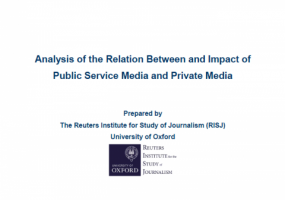Disaster Averted? Television Coverage of the 2013/14 IPCC’s Climate Change Reports

New RISJ report examines country differences in the television reporting of climate change A new study on the television coverage of the 2013/4 blockbuster reports by the Intergovernmental Panel on Climate Change (IPCC) shows similarities and differences between countries in the way they cover climate change.
Six countries were examined - Australia, Brazil, China, Germany, India and the UK. In those countries which covered the IPCC reports, the reporting shared a strong emphasis on portraying the adverse impacts or ‘disaster’ elements of the climate change story. Compared to the other three frames examined (uncertainty, opportunity, and explicit risk), disaster was the most present, the most salient and the most dominant.[i]
Although the IPCC put considerable emphasis on ‘risk management’ in its communication efforts, the ‘explicit risk’ frame was the least present. But there were important variations in how much attention the television channels paid to climate sceptics and the climate ‘pause’ (the lack of a significant rise in global average temperatures since 1998). The BBC in the UK and ABC in Australia were the two channels of the six examined to delve into the ‘pause’.
Of the other four countries, there was only a brief mention on Jornal Nacional in Brazil. The UK was the only country to have a sceptic appear on screen in the bulletins monitored, although there was a generic mention of ‘sceptics’ on Jornal Nacional in Brazil. ‘Our results endorse the findings in other studies that show the strong presence of sceptics and sceptic discourses in ‘Anglo-sphere’ countries like Australia, the UK, and the USA, but much less presence in other countries’, says James Painter, the author of the report.
The 2011 RISJ publication, Poles Apart, showed that climate scepticism was widespread in the print media in the UK and the USA, but virtually absent from Brazil, China, France, and India. ‘Disaster Averted?’ is unusual as it is one of the few to focus on television (which is still the most trusted and used source of news in most countries), on the IPCC reports, and on a combination of developed and developing countries. In each country a channel was chosen that commanded a significant audience, often the largest in the country for an evening news bulletin, and often the most trusted. The combined audience of the six channels was around 50 million. The six channels were ABC 1 in Australia; TV Globo in Brazil; CCTV-1 in China; ARD in Germany; Aaj Tak in India, and the BBC in the UK.[ii]
Other important findings were that, whilst Australia, Brazil, Germany and the UK carried considerable coverage of the reports, China had just 40 seconds, and India no coverage. Only two of the thirteen bulletins used the IPCC language of likelihood and confidence levels, and one of these gave a full explanation of what they meant. IPCC authors and other scientists were almost exclusively the interviewees who appeared on screen during the reports. The four frames (disaster, uncertainty, opportunity, and explicit risk) are common ways of presenting the climate change story. However, they are subject to considerable scrutiny as to their efficacy in promoting public understanding, engagement, or behaviour change. For example, doom-laden depictions of climate change are ubiquitous in the media, and yet such disaster narratives are not regarded as helpful to genuine personal engagement. One of the report’s conclusions is that ‘television news needs pictures to tell stories, and is better at telling stories than dealing with issues. The disaster frame lends itself to a strong narrative, whereas risk for example is more of an issue than a story. It will remain a major challenge to shift the dominant narratives around climate change, particularly as television is such an important medium for many publics’.
[i] Presence is measured by the appearance of the frame anywhere in an article and salience by their presence in headlines or the opening element of the report. Dominance includes a wide variety of indicators such as the relative weight of a frame throughout an article, salience, prominent quotes, and the use of language such as metaphors and adjectives.
[ii] One evening bulletin on one channel in each country the day before and the day of the release of the three IPCC Working Group (WG) reports which came out in September 2013, March 2014, and April 2014 respectively. This gave a total of 36 bulletins, of which 13 carried items on the IPCC reports.
[View the story "Disaster Averted? Television Coverage of the 2013/14 IPCC’s Climate Change Reports" on Storify]
Published by the Reuters Institute for the Study of Journalism with the support of the Grantham Research Institute on Climate Change and the Environment at the London School of Economics and Political Science, and the Norwegian Environment Agency.

This report can be reproduced under the Creative Commons licence CC BY. For more information please go to this link.





